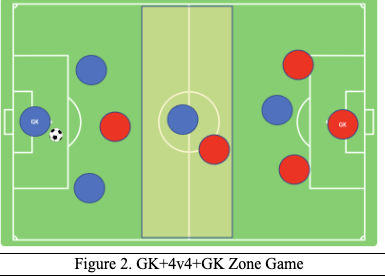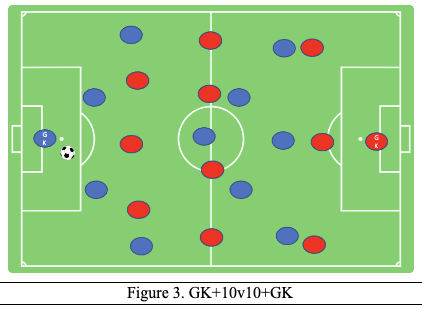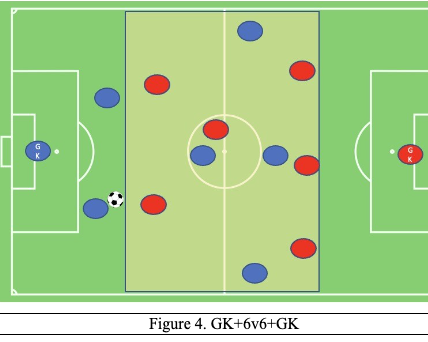Training a Tactical Periodization Game Idea Principle: An Example of Ball Progression
(Part 3)
Our first blog introduced the idea of tactical periodization developed by Professor Vitor Frade, which involves the process of generating a game idea to inform coaching practices and activities to prepare athletes for the complex multiplicities of competition. Our second blog, showed how to exercise a game idea through methodological principles. In the following blog, we’ll operationalize a hypothetical game idea principle and three distinct but related training activities at different scales (i.e., macro, meso, and micro), which in turn will also target different types of contractions (i.e., duration, velocity, and tension). In this way we show how to train “progression of the ball” as one of our principles of our game idea. First, before providing specific activities, we outline some potential complexities of movements and skills that would be involved for “progressing the ball" at different scales.
Using the framework described in our previous two blogs to design dynamic and adaptable playing principles, our principle of Ball Progression (i.e., progressing the ball) respects the three variables of the framework: intentionality (i.e., a clear intention but open to interpretation), fractals (i.e., patterns recreated at the large and miniature levels) and articulation of sense (i.e., naturally connected and interdependent to our other offensive playing principles; and our defensive principles).
Macro Principles: the general patterns of play that characterize the team intention in the game situation, the identity of the team.
-
Ball Progression
Meso Principles: the intermediate patterns of play that bring the macro principles to life and create the dynamics of the team. The meso scale defines the roles to achieve the macro intention.
-
Intent to combine or break lines through pass or dribble.
-
Offensive unity
-
Generation of superiorities
-
Forward runs into the depth
Micro Principles: the individual actions/interactions that allow the execution of the meso (roles) and the macro (collective intention) scales of the game idea; emerge as a function of the dynamics between the macro and meso principles.
Recall that the micro principles are the “unpredictability to the predictability” of the play, as the players govern what actions and interactions are possible as they attempt to express the macro and meso ideas. We list some possibilities below but emphasize this is not an extensive list.
-
Dribbles, combination passes, 1v1 skill, different rhythms of play
-
Minimizing the vertical distances between positional lines, preparing the defensive transition moment
-
Positional, numerical, dynamic, qualitative, socio-affective superiorities: 2v1, overlaps / underlaps, creation of triangle and diamond structures
-
Establish and explore the depth behind the defensive lines, runs into open space, reception between lines
Once the possibilities are outlined in respect to the game principle (Ball Progression) at different scales on the field, more specific coaching activities can be created with further consideration for complexity, horizonal alteration and propensities. In this way, the players are able to better work together because they are on the same page, while also considering and addressing multiple aspects of performance specific to game play.
Wednesday – Day of Micro Principles (Dominant muscular contraction: tension)
Building upon the priorities above, as an example, on Wednesday we aim to achieve a low to moderate complexity to promote the muscular contraction of tension to execute the micro principles of the ball progression game principle. The tension of muscular contraction (i.e., represented with the blue color in the pattern morphocycle schematic) can be conceptualized as the body’s mechanism to start and go or elude obstacles in fluidity. When thinking about the demands of football we can quickly recognize the importance for players to emphasize the tension of contraction as many actions involve stop-and-go (i.e., jumping to head the ball, 1v1 accelerations, change in direction while defending, etc.).
Therefore, the acquisition-focus of the training activities will be mainly directed at the micro-level, typically characterized as the day with the most stoppages, rest intervals or breaks. This is done in order to minimize disruption to the recovery dynamics occurring at the collective level and to adequately target the fast fibers to perform actions of maximum tension but always in relation to our way of playing. In other words, because we are concerned with training the micro principles on this day and the individual details of our game idea, we design exercises of smaller complexity to promote that specific acquisition at the induvial level, which in turn ensures that there are intense situations of tension of the muscle contraction (also referred to maximum dynamic extensibilities). The example below provides an example of one activity to be used on this given day.
In Figure 2 we see a GK+4v4+GK training activity to train the principle of ball progression. We set a few conditions to promote the meso-principles so that the players can achieve them through some of the micro behaviors and interactions we outlined before.
Set-up
-
Two teams of 4 plus a goalkeeper for each team
-
Three marked zones of 18 W x 36 L yards (i.e., a small field divided into thirds)
-
Line-up: 1-2-1-1 (the GK and the two defenders in one zone, one midfielder in the second zone, and a striker in the final zone)
Game Conditions
-
When a team is out of possession, the players are restricted to defend in their zone only
-
In possession teams can move into any zone – if the ball is lost, they can quickly press in the zone they are but cannot move back into their original zone until the ball is scored or played out
-
If the team scores a goal and is occupying two zones (excluding the goalkeeper), the goal is worth 3 points, if the goal is scored and at least one player is in each zone then the goal is only worth 1 point
With this simple set-up and adjustment of propensities, we can firmly promote micro behaviors that are directly linked to the execution of our macro idea of Ball Progression:
-
Passes and dribbles to get the ball forward
-
Angles of reception and support to the ball carrier
-
Creation of various superiorities and movement to create space and advantages
-
Staying connected to the game in-front of you, being close to prepare the transition moments.
Thursday – Day of Macro Principles (Dominant muscular contraction: duration)
Based on figure 1, Thursday has been outlined as a day of high complexity and duration. In Figure 3 we demonstrate a macro scale activity example that addresses high complexity and duration in relation to the Ball Progression game idea. The graphical representation of this day is designated green (to promote the type of perturbations experienced on the game day which is also a shade of green). This distinction between the macro day and the game day is due to the fact that the training session will lack several elements that are present in the game day: the psychological and emotional impact will be lower, as well as the ability to control the exercises times (i.e. allowing for stoppages to coach, hydrate or rest) and therefore the green is not as “pure” as that of the game day. To promote these perturbations amongst the team it will be necessary to structure the session to emphasize the duration of the muscular contraction, by amplifying the playing spaces, number of players and length of exercise times but in a density of intermittence of the game-day-demands. However, the day should not be thought of as a “day of endurance” or the “day of 11v11” it is more than that. This is the day to address the macro and meso aspects of our game idea in situations of greater complexity and collective organization.
In Figure 3 we see a GK+10v10+GK training activity that is very similar to the game on Wednesday but now produced at a macro scale, involving higher complexity as more space and number of players are involved.
Set-up
-
Two teams of 10 plus goalkeepers for each team
-
11v11 sized field
Game Conditions
-
Normal rules of play (offsides, throw-ins, fouls, etc.)
-
Progression past midfield by the team in possession = 1 point
-
Goal scored with entire team past midfield (except the GK) = 3 points, otherwise the goal is only worth 1 point
Although the designed activity now occurs on a larger scale with slightly different conditions from the first activity, the underlying global intention of Ball Progression, doesn’t change. To achieve this macro idea the fluidity and interaction of the meso relationships become critical:
-
The intent and decision of when to play forward, conquering space individually or in combination
-
Creating various superiorities in different zones as the ball is progressed
-
Dynamic movement to receive passes or into space so as to progress the game forwards
-
Vertical movements of players to squeeze the spaces in-front as the ball progressing so that a goal scored can be worth 3 points vs 1 point
Friday – Day of Meso/Micro Principles (Dominant muscular contraction: velocity)
Graphically represented as yellow, signifying the dominant muscular contraction of velocity, the dynamics of this day should promote sprinting situations and of very short duration. To achieve this, it is necessary to create training contexts with playing spaces that are sufficiently long and rather lower propensities of transitional situations in order to allow for the maximum velocity of muscular contraction to occur. The idea should be to minimize “playing impediments” (i.e., players to overcome, transition moments) to allow players to achieve maximum speed in distances of 15 to 20 yards without having to constantly stop and overly think the situation to readjust their movements.
In Figure 4 we present a GK+6v6+GK game, again a similar game to that of Wednesday and Thursday but now adapt some dynamics of the game and the spacing of the middle zone to emphasize some of the micro principles in larger spaces and numbers (i.e., meso-scale relationships).
Set-up
-
Two teams of 6 plus goalkeepers for each team
-
Three zones: outer zones 40 W x 25 L yards, middle zone 40 W x 30 L yards
Game Conditions
-
In possession the defenders can drop out of the middle zone to circulate the ball (in the image two blue have dropped out, red cannot exit the middle zone to press them)
-
The objective of the game is to break out of the middle zone, once the middle zone is surpassed the defending team cannot follow to pressure, the exiting team is free to goal (5 seconds to score)
Again, the idea here is promoting players to make runs and movements in behind or find combinations that allow them to progress forwards with speed. The need to score in 5 seconds after making fast movements to break forwards will emphasize the muscular contraction of speed in our players.
-
Decision of when to play forward; weight of the pass, control or dribble to break lines with speed.
-
Identifying and creating different combination to progress; angles of support to set-up or take advantage of the line-breaking pass.
-
Variation in movements to exploit space; changes of pace to run-in behind or move close to receive the ball away from defenders.
-
Squeeze the spaces in-front; positioning to prepare the transition moment and prevent the forward pass from the opponent.
Summary
In this blog, we showed examples of how methodological principles of tactical periodization can be applied to establish specificity within the training process. We addressed ways to engage temporal spacing, establish morphocycle patterns, and provided practical examples for structuring training activities across different days of the training week to be used to practice and exercise the game idea of “Ball Progression”. Our conceptions of tactical periodization should be leveraged as a tool to address the complex and dynamic issues of team and player development and to guide the process for having each player learn and have team cohesiveness towards the game idea, which is under constant construction.
Interested readers are also encouraged to seek out and familiarize themselves with the official school of Tactical Periodization by Vitor Frade at https://tacticalperiodization.teachable.com/.







